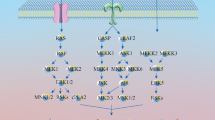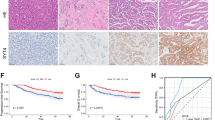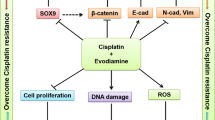Abstract
Medulloblastoma is one of the leading causes of morbidity and mortality in pediatric cancer. Wnt-active tumors, an independent molecular subgroup in medulloblastoma, are characterized by a distinct pattern of genomic aberrations. We assessed the anticancer activity of cantharidin and norcantharidin against medulloblastoma, as cell lines in vitro and in athymic nude mice in vivo. Cantharidin and norcantharidin treatment impaired the growth of DAOY and UW228 medulloblastoma cells and promoted the loss of β-catenin activation and the β-catenin nuclearization linked to N-cadherin impairment in vitro. Intra-peritoneal administration of norcantharidin inhibited the growth of intra-cerebellum tumors in orthotopic xenograft nude mice. Analysis of the xenograft tissues revealed enhanced neuronal differentiation and reduced β-catenin expression. Our findings suggest that norcantharidin has potential therapeutic applications in the treatment of medulloblastoma as a result of its ability to cross the blood–brain barrier and its impairment of Wnt-β-catenin signaling.




Similar content being viewed by others
References
de Bont JM, Packer RJ, Michiels EM, den Boer ML, Pieters R (2008) Biological background of pediatric medulloblastoma and ependymoma: a review from a translational research perspective. Neuro Oncol 10(6):1040–1060
Wang Q, Li H, Liu N, Chen XY, Wu ML, Zhang KL, Kong QY, Liu J (2008) Correlative analyses of notch signaling with resveratrol-induced differentiation and apoptosis of human medulloblastoma cells. Neurosci Lett 438(2):168–173
Yang ZJ, Ellis T, Markant SL, Read TA, Kessler JD, Bourboulas M, Schuller U, Machold R, Fishell G, Rowitch DH, Wainwright BJ, Wechsler-Reya RJ (2008) Medulloblastoma can be initiated by deletion of patched in lineage-restricted progenitors or stem cells. Cancer Cell 14(2):135–145
Gilbertson RJ, Ellison DW (2008) The origins of medulloblastoma subtypes. Annu Rev Pathol 3:341–365
Guessous F, Li Y, Abounader R (2008) Signaling pathways in medulloblastoma. J Cell Physiol 217(3):577–583
Grotzer MA, von Hoff K, von Bueren AO, Shalaby T, Hartmann W, Warmuth-Metz M, Emser A, Kortmann RD, Kuehl J, Pietsch T, Rutkowski S (2007) Which clinical and biological tumor markers proved predictive in the prospective multicenter trial HIT’91—implications for investigating childhood medulloblastoma. Klin Padiatr 219(6):312–317
Pfister S, Remke M, Benner A, Mendrzyk F, Toedt G, Felsberg J, Wittmann A, Devens F, Gerber NU, Joos S, Kulozik A, Reifenberger G, Rutkowski S, Wiestler OD, Radlwimmer B, Scheurlen W, Lichter P, Korshunov A (2009) Outcome prediction in pediatric medulloblastoma based on DNA copy-number aberrations of chromosomes 6q and 17q and the MYC and MYCN loci. J Clin Oncol 27(10):1627–1636
Ellison DW, Kocak M, Dalton J, Megahed H, Lusher ME, Ryan SL, Zhao W, Nicholson SL, Taylor RE, Bailey S, Clifford SC (2010) Definition of disease-risk stratification groups in childhood medulloblastoma using combined clinical, pathologic, and molecular variables. J Clin Oncol 29:1400–1407
Clifford SC, O’Toole K, Ellison DW (2009) Chromosome 1q gain is not associated with a poor outcome in childhood medulloblastoma: requirements for the validation of potential prognostic biomarkers. Cell Cycle 8(5):787
Kool M, Koster J, Bunt J, Hasselt NE, Lakeman A, van Sluis P, Troost D, Meeteren NS, Caron HN, Cloos J, Mrsic A, Ylstra B, Grajkowska W, Hartmann W, Pietsch T, Ellison D, Clifford SC, Versteeg R (2008) Integrated genomics identifies five medulloblastoma subtypes with distinct genetic profiles, pathway signatures and clinicopathological features. PLoS One 3(8):e3088
Northcott PA, Korshunov A, Witt H, Hielscher T, Eberhart CG, Mack S, Bouffet E, Clifford SC, Hawkins CE, French P, Rutka JT, Pfister S, Taylor MD (2010) Medulloblastoma comprises four distinct molecular variants. J Clin Oncol 29(11):1408–1414
Holthouse DJ, Dallas PB, Ford J, Fabian V, Murch AR, Watson M, Wong G, Bertram C, Egli S, Baker DL, Kees UR (2009) Classic and desmoplastic medulloblastoma: complete case reports and characterizations of two new cell lines. Neuropathology 29(4):398–409
Katoh Y, Katoh M (2009) Hedgehog target genes: mechanisms of carcinogenesis induced by aberrant hedgehog signaling activation. Curr mol med 9(7):873–886
Perez-Martinez A, Lassaletta A, Gonzalez-Vicent M, Sevilla J, Diaz MA, Madero L (2005) High-dose chemotherapy with autologous stem cell rescue for children with high risk and recurrent medulloblastoma and supratentorial primitive neuroectodermal tumors. J Neurooncol 71(1):33–38
Rogers HA, Miller S, Lowe J, Brundler MA, Coyle B, Grundy RG (2009) An investigation of WNT pathway activation and association with survival in central nervous system primitive neuroectodermal tumours (CNS PNET). Br J Cancer 100(8):1292–1302
Ellison DW, Onilude OE, Lindsey JC, Lusher ME, Weston CL, Taylor RE, Pearson AD, Clifford SC (2005) Beta-catenin status predicts a favorable outcome in childhood medulloblastoma: the United Kingdom children’s cancer study group brain tumour committee. J Clin Oncol 23(31):7951–7957
Rogers L, Pattisapu J, Smith RR, Parker P (1988) Medulloblastoma in association with the Coffin-Siris syndrome. Childs Nerv Syst 4(1):41–44
Zhai Y, Wu R, Schwartz DR, Darrah D, Reed H, Kolligs FT, Nieman MT, Fearon ER, Cho KR (2002) Role of beta-catenin/T-cell factor-regulated genes in ovarian endometrioid adenocarcinomas. Am J Pathol 160(4):1229–1238
Efferth T, Rauh R, Kahl S, Tomicic M, Bochzelt H, Tome ME, Briehl MM, Bauer R, Kaina B (2005) Molecular modes of action of cantharidin in tumor cells. Biochem Pharmacol 69(5):811–818
Rauh R, Kahl S, Boechzelt H, Bauer R, Kaina B, Efferth T (2007) Molecular biology of cantharidin in cancer cells. Chin Med 2:8
Shan HB, Cai YC, Liu Y, Zeng WN, Chen HX, Fan BT, Liu XH, Xu ZL, Wang B, Xian LJ (2006) Cytotoxicity of cantharidin analogues targeting protein phosphatase 2A. Anticancer Drugs 17(8):905–911
Huan SK, Lee HH, Liu DZ, Wu CC, Wang CC (2006) Cantharidin-induced cytotoxicity and cyclooxygenase 2 expression in human bladder carcinoma cell line. Toxicology 223(1–2):136–143
Dorn DC, Kou CA, Png KJ, Moore MA (2009) The effect of cantharidins on leukemic stem cells. Int J Cancer 124(9):2186–2199
Sagawa M, Nakazato T, Uchida H, Ikeda Y, Kizaki M (2008) Cantharidin induces apoptosis of human multiple myeloma cells via inhibition of the JAK/STAT pathway. Cancer Sci 99(9):1820–1826
Hill TA, Stewart SG, Sauer B, Gilbert J, Ackland SP, Sakoff JA, McCluskey A (2007) Heterocyclic substituted cantharidin and norcantharidin analogues—synthesis, protein phosphatase (1 and 2A) inhibition, and anti-cancer activity. Bioorg Med Chem Lett 17(12):3392–3397
Hill TA, Stewart SG, Gordon CP, Ackland SP, Gilbert J, Sauer B, Sakoff JA, McCluskey A (2008) Norcantharidin analogues: synthesis, anticancer activity and protein phosphatase 1 and 2A inhibition. Chem Med Chem 3(12):1878–1892
McCluskey A, Ackland SP, Bowyer MC, Baldwin ML, Garner J, Walkom CC, Sakoff JA (2003) Cantharidin analogues: synthesis and evaluation of growth inhibition in a panel of selected tumour cell lines. Bioorg Chem 31(1):68–79
Huang Y, Liu Q, Liu K, Yagasaki K, Zhang G (2009) Suppression of growth of highly-metastatic human breast cancer cells by norcantharidin and its mechanisms of action. Cytotechnology 59(3):209
Luan J, Duan H, Liu Q, Yagasaki K, Zhang G (2010) Inhibitory effects of norcantharidin against human lung cancer cell growth and migration. Cytotechnology 62(4):349–355
Chen YJ, Tsai YM, Kuo CD, Ku KL, Shie HS, Liao HF (2009) Norcantharidin is a small-molecule synthetic compound with anti-angiogenesis effect. Life Sci 85(17–18):642–651
Chen YN, Chen JC, Yin SC, Wang GS, Tsauer W, Hsu SF, Hsu SL (2002) Effector mechanisms of norcantharidin-induced mitotic arrest and apoptosis in human hepatoma cells. Int J Cancer 100(2):158–165
Kok SH, Cheng SJ, Hong CY, Lee JJ, Lin SK, Kuo YS, Chiang CP, Kuo MY (2005) Norcantharidin-induced apoptosis in oral cancer cells is associated with an increase of proapoptotic to antiapoptotic protein ratio. Cancer Lett 217(1):43–52
Kok SH, Hong CY, Kuo MY, Lee CH, Lee JJ, Lou IU, Lee MS, Hsiao M, Lin SK (2003) Comparisons of norcantharidin cytotoxic effects on oral cancer cells and normal buccal keratinocytes. Oral Oncol 39(1):19–26
Peng C, Liu X, Liu E, Xu K, Niu W, Chen R, Wang J, Zhang Z, Lin P, Wang J, Agrez M, Niu J (2009) Norcantharidin induces HT-29 colon cancer cell apoptosis through the alphavbeta6-extracellular signal-related kinase signaling pathway. Cancer Sci 100(12):2302–2308
Bonness K, Aragon IV, Rutland B, Ofori-Acquah S, Dean NM, Honkanen RE (2006) Cantharidin-induced mitotic arrest is associated with the formation of aberrant mitotic spindles and lagging chromosomes resulting, in part, from the suppression of PP2A-alpha. Mol Cancer Ther 5(11):2727–2736
Yang J, Wu J, Tan C, Klein PS (2003) PP2A:B56epsilon is required for Wnt/beta-catenin signaling during embryonic development. Development 130(23):5569–5578
Li W, Xie L, Chen Z, Zhu Y, Sun Y, Miao Y, Xu Z, Han X (2010) Cantharidin, a potent and selective PP2A inhibitor, induces an oxidative stress-independent growth inhibition of pancreatic cancer cells through G2/M cell-cycle arrest and apoptosis. Cancer Sci 101(5):1226–1233
Sakoff JA, Ackland SP, Baldwin ML, Keane MA, McCluskey A (2002) Anticancer activity and protein phosphatase 1 and 2A inhibition of a new generation of cantharidin analogues. Invest New Drugs 20(1):1–11
Cimmino F, Schulte JH, Zollo M, Koster J, Versteeg R, Iolascon A, Eggert A, Schramm A (2009) Galectin-1 is a major effector of TrkB-mediated neuroblastoma aggressiveness. Oncogene 28(19):2015–2023
Garzia L, Andolfo I, Cusanelli E, Marino N, Petrosino G, De Martino D, Esposito V, Galeone A, Navas L, Esposito S, Gargiulo S, Fattet S, Donofrio V, Cinalli G, Brunetti A, Vecchio LD, Northcott PA, Delattre O, Taylor MD, Iolascon A, Zollo M (2009) MicroRNA-199b-5p impairs cancer stem cells through negative regulation of HES1 in medulloblastoma. PloS One 4(3):e4998
Yokota N, Mainprize TG, Taylor MD, Kohata T, Loreto M, Ueda S, Dura W, Grajkowska W, Kuo JS, Rutka JT (2004) Identification of differentially expressed and developmentally regulated genes in medulloblastoma using suppression subtraction hybridization. Oncogene 23(19):3444–3453
van Noort M, Meeldijk J, van der Zee R, Destree O, Clevers H (2002) Wnt signaling controls the phosphorylation status of beta-catenin. J Biol Chem 277(20):17901–17905
Massicot F, Dutertre-Catella H, Pham-Huy C, Liu XH, Duc HT, Warnet JM (2005) In vitro assessment of renal toxicity and inflammatory events of two protein phosphatase inhibitors cantharidin and nor-cantharidin. Basic Clin Pharmacol Toxicol 96(1):26–32
Barker N, Clevers H (2006) Mining the Wnt pathway for cancer therapeutics. Nat Rev Drug Discov 5(12):997–1014
Baryawno N, Sveinbjornsson B, Kogner P, Johnsen JI (2010) Medulloblastoma: a disease with disorganized developmental signaling cascades. Cell Cycle 9(13):2548–2554
Baryawno N, Sveinbjornsson B, Eksborg S, Chen CS, Kogner P, Johnsen JI (2010) Small-molecule inhibitors of phosphatidylinositol 3-kinase/Akt signaling inhibit Wnt/beta-catenin pathway cross-talk and suppress medulloblastoma growth. Cancer Res 70(1):266–276
Widau RC, Jin Y, Dixon SA, Wadzinski BE, Gallagher PJ (2010) Protein phosphatase 2A (PP2A) holoenzymes regulate death-associated protein kinase (DAPK) in ceramide-induced anoikis. J Biol Chem 285(18):13827–13838
Chen YJ, Shieh CJ, Tsai TH, Kuo CD, Ho LT, Liu TY, Liao HF (2005) Inhibitory effect of norcantharidin, a derivative compound from blister beetles, on tumor invasion and metastasis in CT26 colorectal adenocarcinoma cells. Anti-cancer drugs 16(3):293–299
Chen YN, Cheng CC, Chen JC, Tsauer W, Hsu SL (2003) Norcantharidin-induced apoptosis is via the extracellular signal-regulated kinase and c-Jun-NH2-terminal kinase signaling pathways in human hepatoma HepG2 cells. Br J Pharmacol 140(3):461–470
Yang H, Guo W, Xu B, Li M, Cui J (2007) Anticancer activity and mechanisms of norcantharidin-Nd3II on hepatoma. Anticancer Drugs 18(10):1133–1137
Chuang KA, Lieu CH, Tsai WJ, Wu MH, Chen YC, Liao JF, Wang CC, Kuo YC (2010) Evaluation of anti-Wnt/beta-catenin signaling agents by pGL4-TOP transfected stable cells with a luciferase reporter system. Braz J Med Biol Res 43(10):931–941
Pizem J, Cort A, Zadravec-Zaletel L, Popovic M (2005) Survivin is a negative prognostic marker in medulloblastoma. Neuropathol Appl Neurobiol 31(4):422–428
Mimeault M, Batra SK (2010) Frequent deregulations in the hedgehog signaling network and cross-talks with the epidermal growth factor receptor pathway involved in cancer progression and targeted therapies. Pharmacol Rev 62(3):497–524
Guo X, Wang XF (2009) Signaling cross-talk between TGF-beta/BMP and other pathways. Cell Res 19(1):71–88
Li C, Zhang Y, Lu Y, Cui Z, Yu M, Zhang S, Xue X (2010) Evidence of the cross talk between Wnt and Notch signaling pathways in non-small-cell lung cancer (NSCLC): Notch3-siRNA weakens the effect of LiCl on the cell cycle of NSCLC cell lines. J Cancer Res Clin Oncol 5:771–778
Orsulic S, Huber O, Aberle H, Arnold S, Kemler R (1999) E-cadherin binding prevents beta-catenin nuclear localization and beta-catenin/LEF-1-mediated transactivation. J Cell Sci 112(Pt 8):1237–1245
Zhang L, Sun X, Zhang ZR (2005) An investigation on liver-targeting microemulsions of norcantharidin. Drug Deliv 12(5):289–295
Malaterre J, Ramsay RG, Mantamadiotis T (2007) Wnt-Frizzled signalling and the many paths to neural development and adult brain homeostasis. Front Biosci 12:492–506
Chenn A, Walsh CA (2002) Regulation of cerebral cortical size by control of cell cycle exit in neural precursors. Science 297(5580):365–369
Acknowledgments
This study was funded by PRIN (E5AZ5F) 2008 (MZ), AIRC Tumori Pediatrici 2009–2010 (MZ), European GRANT FP6-EET pipeline LSH-CT-2006-037260 (MZ), and FP7-Tumic HEALTH-F2-2008-201662 (MZ). We thank Dr Hans Clevers (University Hospital, Utrecht, The Netherlands) for generously providing the TOPFLASH and FOPFLASH plasmids, and Dr Alexander Martinkosky and Dr Jill Johnson from the Developmental Therapeutics Program (DCTD), National Cancer Institute, Rockville, USA, and Professor Achille Iolascon from DBBM, University of Naples, Italy, for helpful critical observations during the developmental phase of this project.
Author information
Authors and Affiliations
Corresponding author
Electronic supplementary material
Below is the link to the electronic supplementary material.
Rights and permissions
About this article
Cite this article
Cimmino, F., Scoppettuolo, M.N., Carotenuto, M. et al. Norcantharidin impairs medulloblastoma growth by inhibition of Wnt/β-catenin signaling. J Neurooncol 106, 59–70 (2012). https://doi.org/10.1007/s11060-011-0645-y
Received:
Accepted:
Published:
Issue Date:
DOI: https://doi.org/10.1007/s11060-011-0645-y




